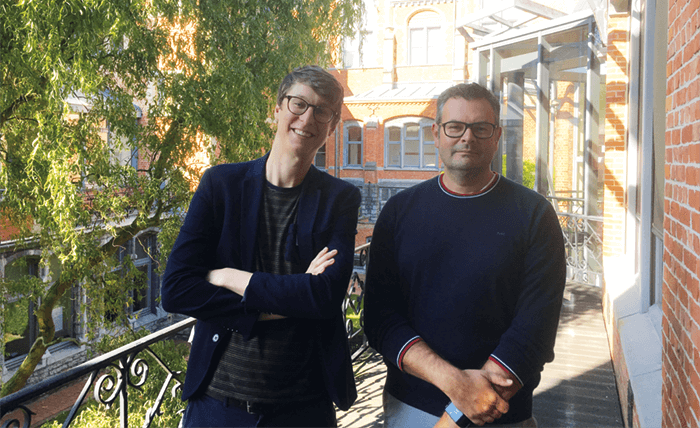How did you get involved in proteomics research?
Kris: I did my Master’s thesis in a proteomics lab in the mid-1990s, and have been in the field ever since. I became a professor at Ghent University in 2004 and a group leader at VIB in 2005. Proteomic technologies developed in our lab are made available to other researchers via our VIB Proteomics Core. Francis: I’m a biomedical scientist by training. It was Kris who introduced me to proteomics – I did my PhD thesis in his lab. After a stint at the Pasteur Institute in Paris, working on bacterial pathogens, I returned to Ghent University and VIB in 2015. I manage the proteomics core facility – a spin-out from Kris’ lab. I also have a small research group “on the side,” which focuses on host–bacteria interactions using proteomics technologies.
What motivates you?
Francis: For me, it’s the strong belief that this technology is enabling real discoveries, as we witness on a weekly basis. There’s still so much to discover – novel interaction partners, novel protein modifications, novel biology! Kris: I also enjoy the opportunity to work with scientists in a variety of disciplines, from plant biologists to clinical scientists.What recent trends have you noticed in the daily routine of the proteomics center?
Francis: Proteomics technology as a whole has matured, with a very rapid evolution of mass spectrometry instruments, separation instruments, and supporting technologies. It’s a very different landscape compared with just a decade ago. As a consequence, some proteomic analyses (such as shotgun analysis for biological samples and mapping protein interaction after affinity purification) have become routine. Of course, there are still many novel kinds of analyses, which are still very much dependent on the expertise of single labs or even single people. Kris: There are certainly some exciting new techniques that allow us to focus on aspects of a protein that we could not study some years ago. In my lab, we invent or trial such techniques to master them and then transfer them back to our Proteomics Core as a new tool for the wider user community.What are the biggest limitations in proteomics?
Francis: With shotgun analysis, we can only routinely measure about half of the proteins expressed in the average mammalian cell. And that is not taking into account the millions of different proteoforms that could also exist. The question is: do they all have meaning? To me though, it’s not a limitation – it’s a challenge.Will the resolving power of mass spectrometers eventually eliminate the need for separation technology?
Kris: The short and simple answer is no. We will always need resolving power, be it LC or other types of chromatography. It is simple mathematics: there could be hundreds of thousands of different peptides in a sample – and it’s impossible to identify that number of molecules without separations.Can improvements in separation technology help overcome the challenges facing proteomics?
Francis: In my view, improving separations is key. Mass spectrometry has seen huge advances over the past 10 years, for example, Orbitrap technology and hybrid machines. To help mass spectrometry reach its full potential, we need to see advances in fractionation too – smaller peaks, more resolution, and higher peak capacities can only increase the overall performance of the analysis. To that end, we have been excited to trial the new micro-pillar array chromatography (µPAC) columns from Pharmafluidics.





